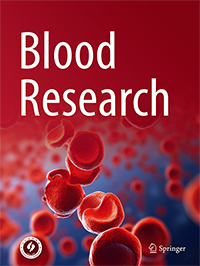Perspective
 Split Viewer
Split Viewer
Blood Res 2016; 51(3):
Published online September 23, 2016
https://doi.org/10.5045/br.2016.51.3.152
© The Korean Society of Hematology
Pre-engraftment syndrome: clinical significance and pathophysiology
Department of Pediatrics, Hanyang University Medical Center, Hanyang University College of Medicine, Seoul, Korea.
This is an Open Access article distributed under the terms of the Creative Commons Attribution Non-Commercial License (http://creativecommons.org/licenses/by-nc/4.0) which permits unrestricted non-commercial use, distribution, and reproduction in any medium, provided the original work is properly cited.
Article
Perspective
Blood Res 2016; 51(3): 152-154
Published online September 23, 2016 https://doi.org/10.5045/br.2016.51.3.152
Copyright © The Korean Society of Hematology.
Pre-engraftment syndrome: clinical significance and pathophysiology
Young-Ho Lee, M.D. Ph.D., and Wee-Jin Rah, M.D.
Department of Pediatrics, Hanyang University Medical Center, Hanyang University College of Medicine, Seoul, Korea.
This is an Open Access article distributed under the terms of the Creative Commons Attribution Non-Commercial License (http://creativecommons.org/licenses/by-nc/4.0) which permits unrestricted non-commercial use, distribution, and reproduction in any medium, provided the original work is properly cited.
Fig 1.

Pathophysiology of capillary leak syndrome, the probable cause of pre-engraftment syndrome. Conditioning chemoradiotherapy can damage the endothelial lining of the gastrointestinal tract, allowing immunostimulatory microbial products such as LPS to enter the circulation. These molecules can stimulate the secretion of inflammatory cytokines (TNF-α, IL-1), leading to secondary release of inflammatory cytokines (cytokine storms). In addition, potentially toxic materials such as G-CSF and the cryoprotectant DMSO, donor stem cells expressing proinflammatory cytokines, and alloreactive donor T cells can also enhance the cytokine storms, thereby contributing to increased vascular permeability to fluids and low-molecular-weight substances.
Abbreviations: LPS, lipopolysaccharide; TNF, tumor necrosis factor; IL, interleukin; G-CSF, granulocyte colony-stimulating factor; DMSO, dimethylsulfoxide.
-
Table 1 . Clinical features of pre-engraftment syndrome..





 PDF
PDF Standard view
Standard view Export citation
Export citation Share
Share  Download
Download Previous Article
Previous Article



